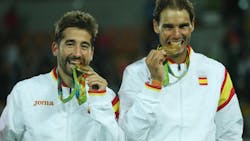Gold, silver, and bronze: How is the oral health of Olympic athletes?
While admiring the stunning smile of Simone Biles, I couldn't stop my 35-year dental veteran self from thinking about Olympic athletes and their oral health. I’ve not had the privilege of treating an Olympian, and I suspect most dental hygienists can say the same.
One of the earliest attempts to assess the oral health of elite athletes was a 1968 pilot study. Conducted by J. O. Forrest, this study examined a group of Olympic contestants to understand the prevalence of dental issues among this high-performance population.1
Some oral health habits of Olympic athletes
When thinking about dental needs and athletes, I would assume that mouthguards are common in contact sports. But aren’t there a host of sayings about assumptions? Depending on the country and age group, there are various regulations for the use of mouthguards in contact sports. For sports such as boxing, taekwondo, and hockey, mouthguards are usually mandatory. By contrast, mouthguards are only recommended for sports such as field hockey, skateboarding, basketball, and equestrian sports, to name a few.2
I contemplated the dental catastrophes that could happen at the games, like an anterior bridge popping off or an impacted wisdom tooth rearing its ugly head. What will the athlete do? There are medical and dental clinics that serve athletes, coaches, and others in the Olympic Village.
When the 2002 winter games were in Salt Lake City, the Salt Lake Olympic Committee (SLOC) asked for volunteers to serve in the dental clinic several years prior to the games. What a spectacular opportunity for dental professionals! The SLOC provided the dental structure, and Lynn Powell, DDS, of the University of Utah School of Health, gathered a team to take on the project of gathering the equipment, supplies, and manpower.
Data from Olympic dental clinics
Through the years, data is recorded from the reception area through treatment in the dental clinics. At the 2008 games, there were about 1,500 cases that involved 1,126 patients who required dental care: 795 cases from 516 athletes, 483 cases from 370 coaches and staff, and 99 cases from volunteers.
Endodontic treatments, permanent fillings, oral hygiene, mouthguards, and treatment of pericoronitis were the most frequent procedures. The extremely popular mouthguards were well utilized, with 122 athletes receiving new custom-made mouthguards in Beijing. The setup had six units, a lab, sterilization, x-rays, and a digital panoramic machine.3
The London Olympics of 2012 had 3,220 visits in the entire medical/dental clinic, and 30%, 858, were dental-related. The highest number of patients were from Europe, followed by Africa and America. The care covered a wide range, from decay, extractions, endodontics, abscesses, mouthguards, and checkups.4
Following the games, a cross-sectional study looked at specifics to evaluate oral health and its determinants and effect on well-being, training, and performance.5 The data was collected from 278 athletes with a mean age of 25.7 years (range 16-47 years), and 57% were men. Participants represented 25 sports, with track and field, boxing, and hockey the most common.
Nearly half of the athletes (46.5%) reported not having a checkup or hygiene visit within 12 months of the games, and 8.7% reported never receiving such care. Of those using mouthguards for sports, more than 40% used a boil-and-bite type, which means it was not custom-made. Five percent of athletes reported current tobacco use, and 7.4% reported they were former users.
When the athletes were polled, 40% said they were "bothered by their oral health," 28% noted an impact on their quality of life, and 18% mentioned an impact on their training and performance. Fifty-five percent had dental caries, 45% experienced moderate to severe tooth erosion, and 76% suffered from periodontal disease, ranging from localized to generalized gingivitis.
The conclusion of the cross-sectional study was, “The oral health of athletes attending the dental clinic of the London 2012 Games was poor, with a resulting substantial negative impact on well-being, training, and performance.”
Why oral health matters for athletes
It’s hard to imagine that coaches don’t understand that oral infections lead to systemic inflammation, which affects the body's ability to recover and perform optimally. Oral disease leads to a higher risk of respiratory infections, which can weaken the immune system and increase susceptibility to injuries.
Caries risk is another issue entirely. Sports-related stress can lead to dehydration and dry mouth. I’m not sure whether elite athletes use energy beverages, but the added sugars and acidic ingredients in them is a straight line to decay and tooth erosion. Areas not included in the data that would be of interest are assessment of airway, and nutritional deficiency for athletes who restrict their diets to meet weight or performance goals. Both can have a significant impact oral health.
As the world stage demands peak performance from athletes, the importance of oral health cannot be overstated. By prioritizing oral care, athletes can enhance their overall well-being, reduce the risk of injuries, and optimize their chances of achieving athletic greatness. When young, burgeoning athletes with dreams of the Olympics visit our operatories, we need to instill in them the value of good oral care and the importance of regular dental visits.
References
1. Forrest JO. The dental condition of Olympic games contestants–a pilot study, 1968. Dent Prac Dent Rec. 1969;20(3):95-101.
2. Sports dentistry guidelines for athletes. FDI World Dental Federation. 2019. https://preprod.fdiworlddental.org/sites/default/files/2020-11/sports_dentistry-guidelines_athletes.pdf
3. Yang X, Schamach P, Dai J, et al. Dental service in 2008 summer Olympic games.
Brit J Sports Med. 2011;45:270-274. doi.10.1136/bjsm.2010.075283
4. Vanhega IS, Palmer-Green D, Soligard T, et al. The London 2012 Summer Olympic Games: an analysis of usage of the Olympic Village ‘polyclinic’ by competing athletes. Brit J Sports Med. 2013;47(7):415-419. doi.10.1136/bjsports-2013-092325
5. Needleman I, Ashley P, Petrie A, et al. Oral health and impact on performance of athletes participating in the London 2012 Olympic games: a cross-sectional study. Brit J Sports Med. 2013;47:1054-1058. doi.10.1136/bjsports-2014-093494.224
About the Author

Anne O. Rice, BS, RDH, CDP, FAAOSH
Anne O. Rice, BS, RDH, CDP, FAAOSH, founded Oral Systemic Seminars after over 35 years of clinical practice and is passionate about educating the community on modifiable risk factors for dementia and their relationship to dentistry. She is a certified dementia practitioner, a longevity specialist, a fellow with AAOSH, and has consulted for Weill Cornell Alzheimer’s Prevention Clinic, FAU, and Atria Institute. Reach out to Anne at anneorice.com.


